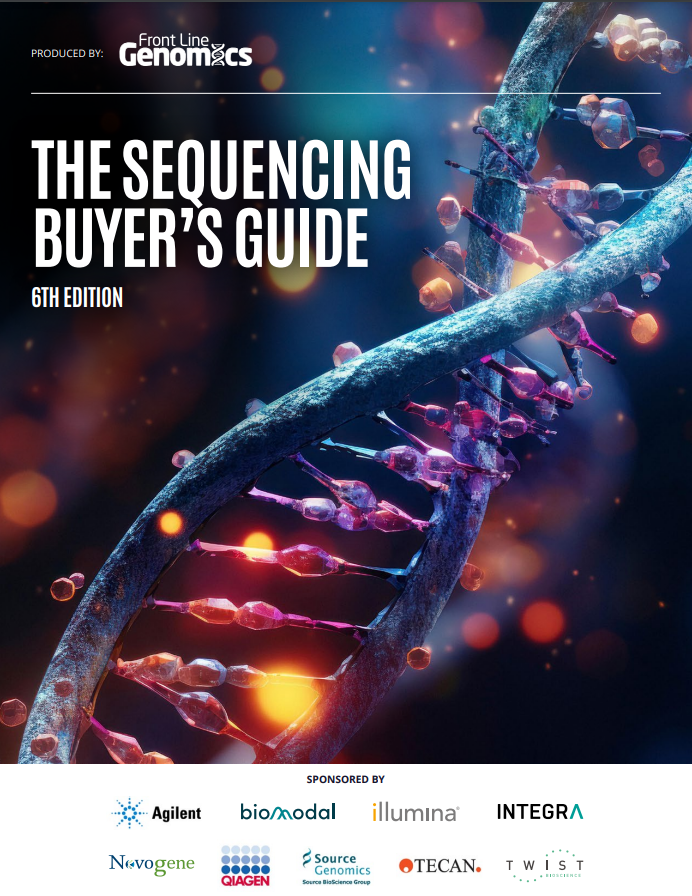
The Sequencing Buyer's Guide: 6th Edition
Next generation sequencing, both short-read and long-read, is undergoing a second wave of exciting developments. New short-read platforms have been released and the accuracy and quality from long-read methods is getting better and better, to the point where they are comparable to short reads. How are you to know which is the best method for your application? What about the best practices for sample prep? For NGS data analysis? Should you use single-cell sequencing?
To help guide you through this journey, we are publishing the Sequencing Buyer’s Guide. This is the 6th edition of our annual free-to-download sequencing intelligence report. From Chapter 1 through 9, you will find advice and direct comparisons of sample prep options, sequencers and everything in between. Furthermore, you will find coverage of the latest and most exciting things happening in sequencing, the race to Q40 and Q50, solid-state nanopores, proteomics and more.
So, to take the next step towards improving your sequencing set up, click the link below
What’s included in the report?
- Contributions from experts across various aspects of sequencing
- Direct comparison of library prep kits and sequencing instruments
- Details on the latest commercial technology developments
- Guidance on selecting a sample prep approach and a sequencing methodology
- Spotlights on single-cell, spatial, multi-omics and proteomic sequencing
- Advice for NGS data analysis, data management and meeting data quality
- Coverage of the latest advances across sequencing including Q40 and solid-state nanopore
- Expert views and practical advice
Hear from our Expert Contributors:
- ·Alex Couto Alves, Head of the Bioinformatics Core Facility & Lecturer in Bioinformatics and Statistical Genomics, University of Surrey
- ·David Baker, Head of Sequencing, The Quadram Institute
- ·Mandovi Chatterjee, Director, Single-cell Core, Harvard Medical School
- ·Josh Fienman, Scientist, Genomics (NGS Technology Center), Pfizer
- Linda Orzolek, Director Single Cell & Transcriptomics Core, John Hopkins University
- Devjanee Swain Lenz, Director, Sequencing and Genome Technologies, Duke Center for Genomic and Computational Biology
- Nancy Cox, Professor of Medicine and Director of the Division of Genetic Medicine, Vanderbilt University
- Howard Mcleod, Professor of Medicine and Biology & Director, Centre for Precision Medicine, Utah Tech University
- Shannon Muir, Chief of Staff, Latino Cancer Institute
- Marylyn Ritchie, Director of Institute for Biomedical Informatics, University of Pennsylvania
- Xinkun Wang, Director, NUSeq Core Facility, Center for Genetic Medicine & Research, Associate Professor, Department of Cell & Developmental Biology, Northwestern University
- Deanna Church, Independent Consultant and Executive-in-Residence, Dmchurch Bio, llc and General Inception
- Miten Jain, Assistant Professor, Northeastern University
- Winston Timp, Associate Professor, John Hopkins University
- Vasiliki Rahimzadeh, Assistant Professor, Center for Medical Ethics and Health Policy, Baylor College of Medicine
- Bradley Malin, Co-Director, Health Data Science Centre, Vanderbilt University
- Angela Page, Director of Strategy and Engagement (GA4GH), The Broad Institute of MIT and Harvard
- Bingjie Zhang, Postdoctoral Research Fellow, Satija Lab, New York Genome Center
- Suhas Vasaikar, Principal Scientist, Clinical Biomarker and Diagnostics, Seattle Genetics
Contents:
Chapter 1: First Steps – Sample Preparation
The foundation of successful analysis is proper sample preparation. This chapter will focus on the first step in sequencing, exploring the popular sample preparation approaches for DNA and RNA sequencing.
Chapter 2: Finding your NGS Library Preparation Kit
Understanding the approaches for sample prep is one thing, but choosing from the various commercial options can be confusing. This chapter will directly compare library prep kits and provide advice on how to choose the right one for your project.
Chapter 3: Meet the Sequencers
This chapter reviews the sequencing instruments currently available. The different types of sequencing technologies will be covered alongside up-to-date technical specifications for each commercially available instrument.
Chapter 4: Finding your Sequencing Technology
You’ve seen the technical specifications in the previous chapter, but that is only half the story when it comes to choosing a sequencing technology. You also need to match your application and needs to the various sequencers that are available. Should you use long-read or short-read? Do you need high-throughput or high accuracy? This chapter will help guide you through this decision-making process.
Chapter 5: Single-cell and Spatial Sequencing
Single-cell and spatial assays have been making waves in the sequencing space for over a decade. This chapter will explore how single-cell sequencing and spatial analysis has changed how we approach sequencing and the value of cell specificity and spatial relationships when it comes to sequencing omics.
Chapter 6: NGS Data Analysis and Data Management
Modern sequencing technologies generate a lot of complex data that requires sophisticated statistical analysis to make sense of it. In this chapter, we will cover some of the latest advances in data analysis, data management and data standards of NGS data.
Chapter 7: What About Outsourcing?
Using an NGS service provider or data analytic service can offer many potential benefits over setting up your sequencing capabilities in house. Could this be the right option for your project?
Chapter 8: Accessibility and ESG in Genomics
This chapter will take a closer look at some pressing social issues in genomics. Namely, how we can increase the diversity of genomic data, improve access to sequencing around the world and the latest environmental, social and corporate governance (ESG) policies that sequencing companies are engaged in.
Chapter 9: What’s New and What’s Next in Sequencing?
This final chapter addresses some of the latest and most exciting innovations from sequencing, whether that is protein sequencing, multi-omics methods, the race to the Q40 quality standard or solid-state nanopore sequencing, you’ll find out about it here.
Download Report
ABOUT US CONTACT ADVERTISE PRIVACY POLICY
Front Line Genomics Limited is registered in England and Wales. Company Number 10421716, VAT: GB 297 742 548.
Registered Office: Ground Floor, Cromwell House, 15 Andover Road, Winchester, Hampshire, SO23 7BT
